Sticking to an exercise regime is not always easy when you have to motivate yourself! This is why it can be necessary for some people to be accompanied in the process. And who better to be your sports coach than your dog!
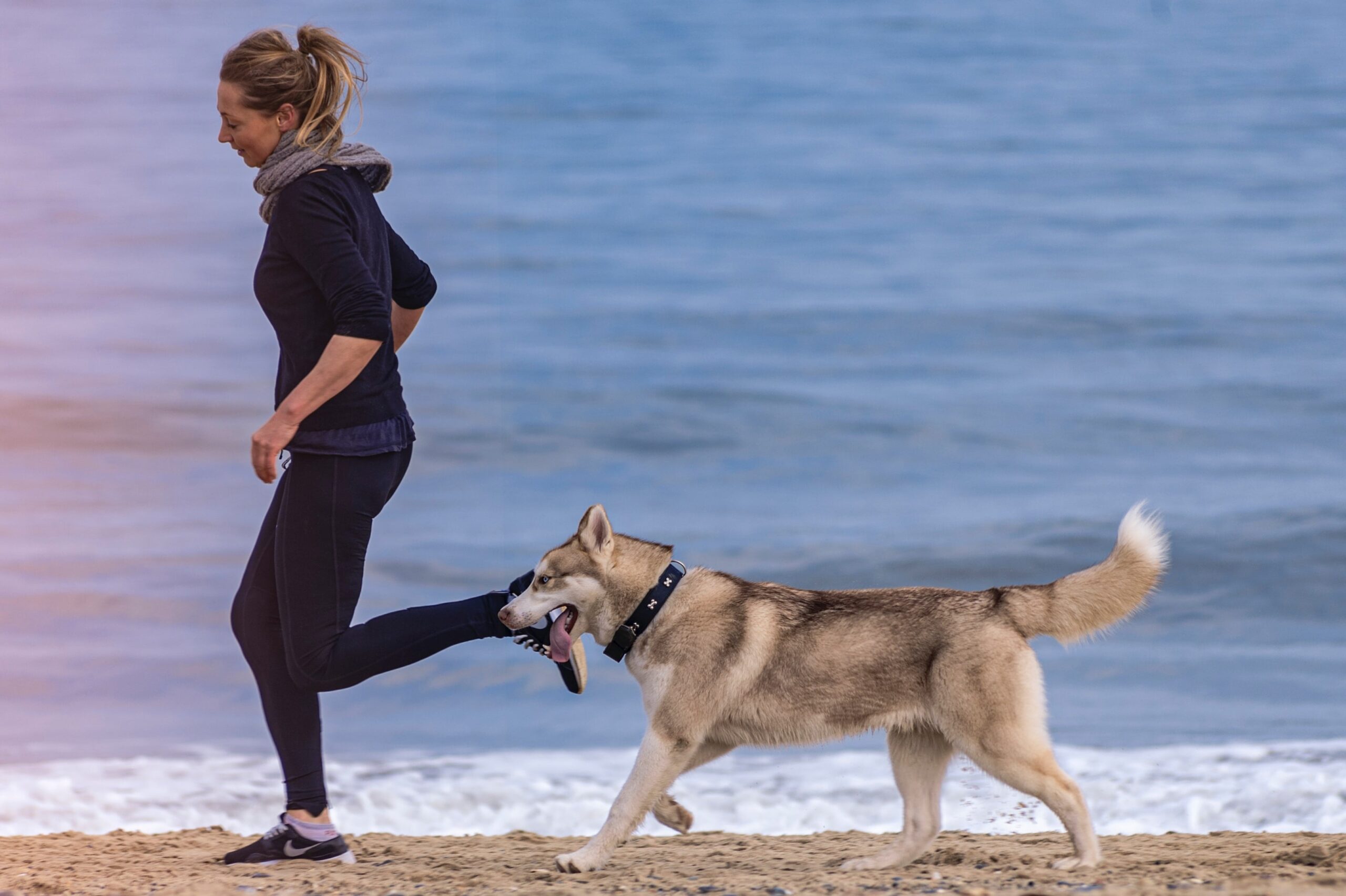
In a previous article, we saw that it is possible to do yoga with your dog. But what about getting your furry friend involved with other workouts?
In the current climate, where working from home has taken over from office work, finding the time and motivation to exercise and go outside has become a real challenge, and as a result many see a decline in their physical and mental health.
Lack of exercise motivation is harming our pets too. Various studies on pet health have found anywhere from 25% – 50% of dogs are considered overweight.
It has never been more important to do sport to feel good mentally and physically.
Resolutions and intentions are good, but actions are better. Deciding to turn off the TV and put on a pair of trainers is much more complicated than it sounds. Being accompanied in your training can be the ideal way to find the necessary motivation! Here’s why your dog is the best workout partner you could have…
5 Reasons to Get Out and Do Some Exercise With Your Dog
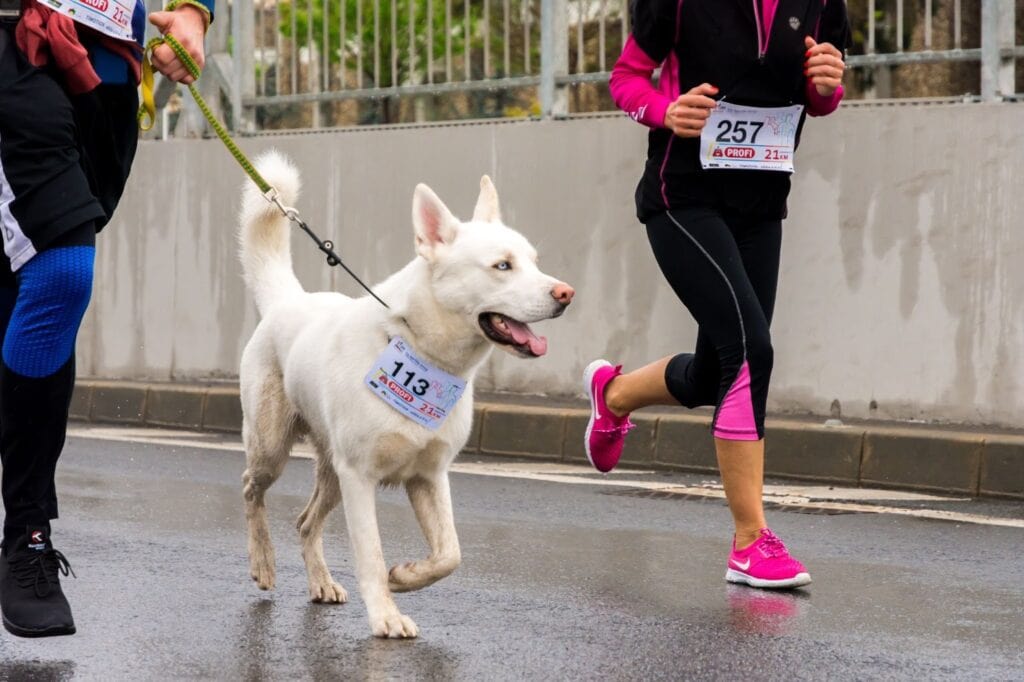
1. Dogs Are Very Energetic and Will Always Be Happy to Go Out
Most dog breeds are happy to go for a walk and are excited to have a run around. Going outside will always be welcomed, unlike like calling a friend to go for a workout and having them be unmotivated or in a bad mood, which will eventually demotivate you.
Dogs are habit-forming animals. If you regularly repeat the action at the same time for several days, it will become a natural ritual for your dog. This is ideal if you are demotivated but don’t want to disappoint your dog. You will still put on your trainers to please your little companion, imposing a certain regularity on you.
2. They Have a Regular Pace
As mentioned above, dogs function very much by habit. But beyond that, apart from when they are ill, they keep a certain pace and will always have a maximum of energy to expend.
Having an active pace allows you to optimise your training and get great results. It is much more fun to follow your dog’s pace than to watch your watch! If you are too slow, your dog will tend to stop. So don’t hesitate to find a pace that suits you both!
3. You Will Always Be Safe With Them
Running or walking alone is not always ideal in terms of safety! Sometimes it’s late in the day and the simple fact of being alone and feeling vulnerable, can be demotivating. The presence of your dog can therefore be a real comfort for your daily outings. A dog has all those senses that are in turmoil when he goes out, so it’s important to trust him, while also keeping an eye on them so that they don’t get hurt either.
4. They Are Always Available
The most complicated thing about doing sport with someone is finding the right time and agreeing on schedules. There is always someone who can’t or would rather be an hour earlier or an hour later than the right time for you! With your dog, this is not an issue. Your dog will always be available, happy, and motivated to come and roam around by your side.
5. They Don’t Ask For Anything in Return – Only Love and Good Times by Your Side!
Dogs will never ask for anything in return for doing sports with you. On the contrary, they will be happy to have spent some quality time with their owner! They are the best coaches you can have. They don’t yell at you (maybe a couple of barks) and you don’t spend money like you would with an experienced sports coach.
What Discipline Should I Do With My Dog?
There are many ways to exercise with your dog. It can be anything from walking to fitness training!
Have you ever heard of canicross? This discipline is an athletic sport where the owner is attached to his dog by a harness. The dog’s traction allows for long strides. It is a bonding moment between the dog and its owner through intense physical effort. This activity is open to all dogs!
Cycling with your dog is also possible! There is equipment that allows you to practice this activity safely with your pet.
Lewis Hamilton’s Best Training Partner Is His Dog!
Multiple F1 champion Lewis Hamilton has released a video of himself training with Roscoe, his dog:
Every time you go out with your dog, energy and good mood is guaranteed!
This entry was posted in Dogs on June 9th, 2021 by juliakretzner
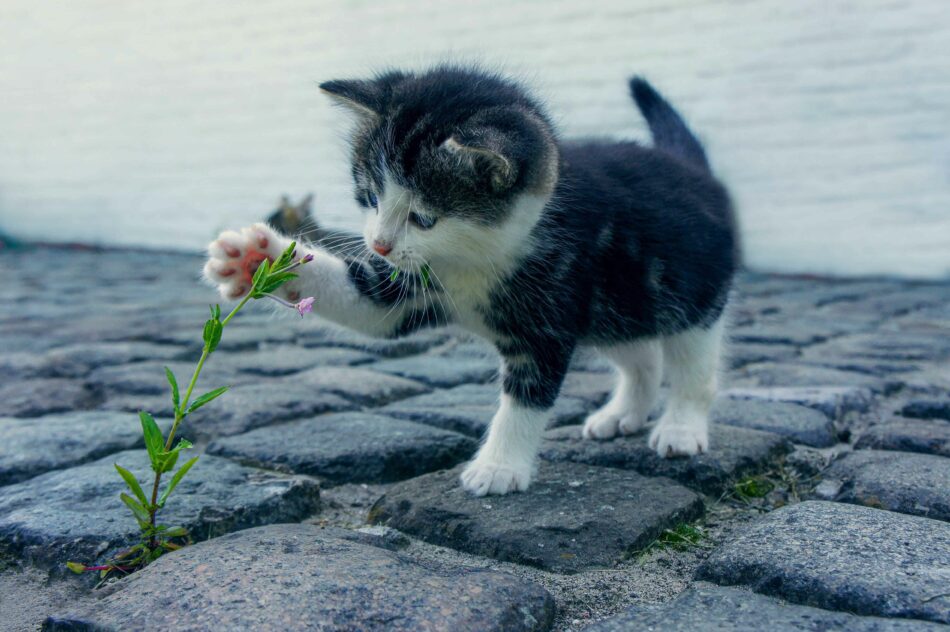
Whether in our gardens or in our homes, plants not only enhance the overall appearance of a space, but they can also help boost moods, increase creativity and reduce stress. But did you know some plants can actually be toxic to your cat if ingested?
While it’s important to know which plants could pose a danger to your furry friend, it is still possible to have green decor and healthy felines coexisting in the same place. So before you forego an indoor nature collection on account of whiskers, browse these 10 cat-friendly plants that are safe for your kitty and look good in your decor.
Why do cats eat plants?
Cats are curious. And just like little children, they often explore new things with their mouths. But if cats are obligate carnivores, or mostly meat eaters, why are they munching on my houseplants? There are several reasons, actually, and it’s best to start with their natural roots.
While most cats are domesticated from the wild, they still possess some innate, instinctual behaviours from their feline ancestors. Eating plants is very common among the cat population and is often something they do to explore textures, help pass a hairball, or even to just increase some nutrient value in their diet. But one of the most common reasons cats eat plants is out of sheer boredom.
You can solve the instinctual desire by only buying cat-friendly plants to keep your cat safe. And having a few sturdy and durable cat scratchers around will help as well. With a cat scratcher like Stak designed by Omlet, you will not only keep boredom at bay, but your cat will be entertained for hours!
10 non-toxic plants for cats
Grasses
If you were to give your cat a grass menu, they would likely choose “clippings from this morning’s mow” or a side helping of “dew-covered sprigs”. When it comes to grasses, most cats are not that picky. But in order to be sure your nursery doesn’t send them to the emergency, stick to harmless grass options such as bluegrass, lemongrass and purple fountain grass.
Ponytail palm plants
Known as the most patient of all houseplants, the ponytail palm plant is both easy to care for and easy on your cat. While it looks (and sounds) like a tropical greenery, this drought-tolerant plant is actually a succulent. In order to maintain its non-needy nature, the ponytail palm stores water in its trunk and produces long curly leaves that look like ponytails. So not only is it safe for your kitty to be around, but it gives your room a calming, tranquil look as well.
Catnip/Nepeta cataria
The only thing your cat loves more than you is catnip. And as luck would have it for you both, this euphoric herb plant is 100% safe for your cat to be around and nibble. Part of the mint family, catnip omits a scent that most cats find simply irresistible. Whether you have it in a planter in the corner or throughout your outdoor garden, cats are wildly attracted to this fragrant plant. In fact, it’s completely normal if you catch your kitty rubbing up against, rolling on or just straight up licking your catnip plant. They literally can’t help it.
Spider plants
When you see a spider in your house, you can usually count on your frisky feline to catch the pesky insect. But what if that spider is on a spider plant? No problem! This cat-friendly plant is completely non-toxic and 100% safe for your kitty to be around. And unlike the legged version, spider plants are easy to care for and simple to maintain.
Prayer plant
If your decor is one that invites a bolder, more colourful style, then a prayer plant may be just the houseplant you, and your cat, need. With striking leaves of striped white and pink colours, these cat-friendly plants are completely safe for your furry friend to be around.
Christmas cactus
While the name may imply that it is only a holiday plant, the Christmas cactus is actually available year-round and is also non-toxic for your cat. More of a succulent than a plant, this feline-friendly cactus produces beautiful pink flowers that are not harmful to your kitty if ingested. And bonus, they add bright colour to your greenery decor.
African violet
One of the most popular flower-blooming houseplants that is also safe for cats is the vibrant African violet. Due to their low maintenance care, many people with, and without, green thumbs like these plants as they add beauty to their space without a lot of requirements. And you can feel at ease knowing the flowers and leaves are not harmful to your cat if nibbled on.
Callisia turtle
This vine-like succulent plant is a great choice for your indoor garden decor as it mystically spills over pots with dense leaves and small white flowers. A unique addition to any home decor, the callisia turtle is also completely feline friendly. In fact, if your cat does eat it, don’t worry – this plant is full of nutrients. Rich in minerals and calcium, the callisia turtle can actually benefit your cat’s digestive system.
Banana tree
Looking to go bigger with your green decor? Then look no further than a banana tree – a dramatic accent plant that is also cat-friendly. The central stems of this tropical plant are often used in human cuisine, so it comes as no surprise that it has also been deemed a safe plant for felines to feast on as well.
Goldenseal
Herb plants are always a great choice when looking for cat-friendly greenery as most are harmless for your cat. Goldenseal sits at the top of the cat-safe list as it’s not only non-toxic but can also be used to treat everyday ailments. Used as a disinfectant for wounds and other sores, goldenseal is known for its soothing and healing properties. In fact, some studies show that, if ingested, goldenseal can help treat ulcers or high blood pressure in your cat as well.
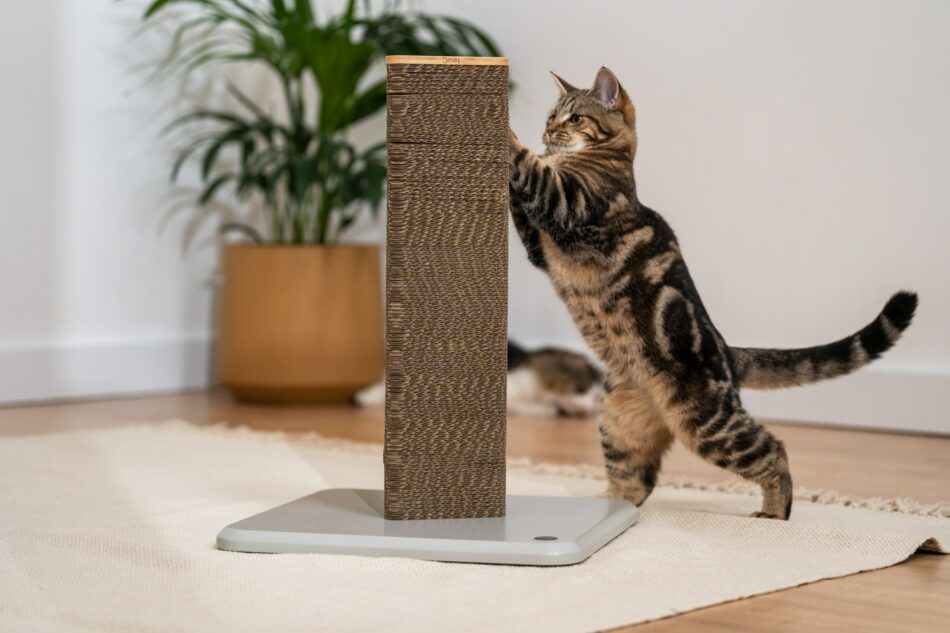
Plants to avoid for your cat
The best defence against your cat’s health is a knowledgeable offence of which houseplants are toxic and potentially dangerous for your furry friend to be around. So if you have a cat in your home, you should be aware of which plants to stay away from to safeguard your cat’s health.
While this list is not exhaustive, some of the more popular indoor and outdoor plants to avoid are: Dieffenbachia, lily of the valley, lily, ficus, azalea, anthurium, daffodil, oleander, holly and mistletoe, poinsettia, yuccas, amaryllis, tulips, and sago palm.
But when purchasing any plants that your cat may be around, it’s best to do your research ahead of time to avoid any doubts or dangers. You can gather information on the internet or consult your vet or the nursery seller for advice as well. And remember, if your cat does ingest or come into contact with any of these toxic plants, you should immediately call or take your cat directly to the vet to seek help.
Omlet and keeping your cat safe
Cats are curious by nature and often unafraid to explore. And while no pet company can stop the inquisitive and common behaviour of plant-eating among cats, we endlessly ask how we can help you both stay safe and happy. With the Stak cat scratcher to end kitty boredom or the Catio outdoor cat enclosure that allows your feline to be in nature safely, we create the products that keep your cat out of trouble.
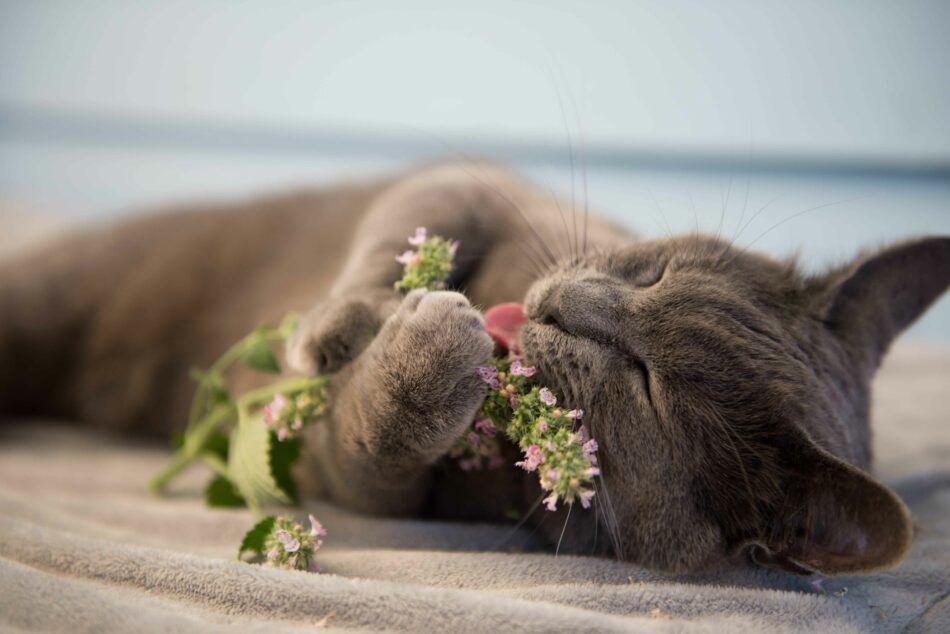
This entry was posted in Cats on June 9th, 2021 by emmaibadioune




